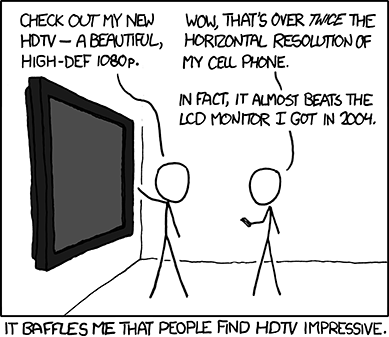732: HDTV
| HDTV |
 Title text: We're also stuck with blurry, juddery, slow-panning 24fps movies forever because (thanks to 60fps home video) people associate high framerates with camcorders and cheap sitcoms, and thus think good framerates look fake. |
Explanation
This comic pokes fun at the differing standard between image quality for television sets and other electronic devices, even though both are based on essentially the same standards. When rating television sets, a 1080p screen, that is, a screen 1,920 pixels wide and 1,080 pixels tall with progressive scan, is considered impressive. In comparison, high-end smartphones in late 2009/early 2010 had 480×800 resolution (with horizontal resolution of 1,920 pixels being more than twice of 800 pixels). As of the comic's publishing date, there had been even higher resolution monitors available (30-inch diagonal 2,560 by 1,600 pixels and 22-inch diagonal 3,840 by 2,400 pixels). In 2004, common desktop monitors had WUXGA resolution of 1,920 wide by 1,200 pixels tall, which is how the TV "almost" (but not quite) has the same resolution as an upper midrange monitor would already have six years earlier.
Soon after the comic's publishing date in 2010, phones with long edge resolution approaching 1,000 pixels were being announced. The first smartphone with a 5-inch full HD screen was announced in November 2012.
The title texts explains another disagreement brought about from the different ways video can be filmed. Often referred to as the Soap Opera Effect, it is the feeling that a viewer gets when watching a film or video with a higher frame rate such as a home films, older sitcoms, or (as the name suggests,) soap operas. The disparity comes from the fact that many small-time productions record with cameras running at 60 frames per second, while big-time productions either record directly on film or set their digital cameras to record at the same 24 frames per second as film. Visual problems such as blur, judder, and slow pans are mostly absent in high-frame rate productions; however, because of the lower budgets of small-time productions, high frame rates are thus associated with a feeling of lower quality. Major films such as The Hobbit and Avatar 2 have attempted to break the norm by shooting with higher frame rates.
Transcript
- [Cueball is pointing to a huge flatscreen HDTV on the wall. His friend is holding a cell phone.]
- Cueball (HDTV Owner): Check out my new HDTV-a beautiful, high-def 1080p.
- Friend: Wow, that's over TWICE the horizontal resolution of my cell phone.
- Friend: In fact, it almost beats the LCD monitor I got in 2004.
- [Caption below the panel:] It baffles me that people find HDTV impressive.
Discussion
But it's on a bigger screen. Jokes aside, I believe TVs are more impressive because the refresh rate is higher and the TV needs more circuitry on the back-end to handle the physically larger screen and the multiple possible inputs. I may be wrong. Davidy22[talk] 13:25, 18 February 2013 (UTC)
The commentary about computer screen sizes needs to be dated and/or updated, as it's clearly outdated. 108.162.212.196 17:17, 11 January 2014 (UTC)
- I don't think that's the case. TV's rely on standards, think of blu-ray, dvd, VHS, DVB-C (cable). A change in media format would require users to buy a new hardware, people are likely not willing to buy new equipment every two years.
- For computers it's different. The video output is generated and not played back. Computers are more flexible and if a format is not supported a simple update can fix everything. Necessaryevil (talk) 15:25, 13 December 2018 (UTC)
 Add comment
Add comment
